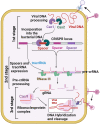A Review on the Mechanism and Applications of CRISPR/Cas9/Cas12/Cas13/Cas14 Proteins Utilized for Genome Engineering
- PMID: 36163606
- PMCID: PMC9512960
- DOI: 10.1007/s12033-022-00567-0
A Review on the Mechanism and Applications of CRISPR/Cas9/Cas12/Cas13/Cas14 Proteins Utilized for Genome Engineering
Abstract
The clustered regularly interspaced short palindromic repeats (CRISPR) and CRISPR-associated protein (CRISPR/Cas) system has altered life science research offering enormous options in manipulating, detecting, imaging, and annotating specific DNA or RNA sequences of diverse organisms. This system incorporates fragments of foreign DNA (spacers) into CRISPR cassettes, which are further transcribed into the CRISPR arrays and then processed to make guide RNA (gRNA). The CRISPR arrays are genes that encode Cas proteins. Cas proteins provide the enzymatic machinery required for acquiring new spacers targeting invading elements. Due to programmable sequence specificity, numerous Cas proteins such as Cas9, Cas12, Cas13, and Cas14 have been exploited to develop new tools for genome engineering. Cas variants stimulated genetic research and propelled the CRISPR/Cas tool for manipulating and editing nucleic acid sequences of living cells of diverse organisms. This review aims to provide detail on two classes (class 1 and 2) of the CRISPR/Cas system, and the mechanisms of all Cas proteins, including Cas12, Cas13, and Cas14 discovered so far. In addition, we also discuss the pros and cons and recent applications of various Cas proteins in diverse fields, including those used to detect viruses like severe acute respiratory syndrome coronavirus-2 (SARS-CoV-2). This review enables the researcher to gain knowledge on various Cas proteins and their applications, which have the potential to be used in next-generation precise genome engineering.
Keywords: CRISPR; Cas system; DETECTR; Genome engineering; SHERLOCK.
© 2022. The Author(s), under exclusive licence to Springer Science+Business Media, LLC, part of Springer Nature.
Conflict of interest statement
The authors declare that there are no competing interests associated with the manuscript.
Figures








Similar articles
-
CRISPR-cas technology: A key approach for SARS-CoV-2 detection.Front Bioeng Biotechnol. 2023 Apr 12;11:1158672. doi: 10.3389/fbioe.2023.1158672. eCollection 2023. Front Bioeng Biotechnol. 2023. PMID: 37214290 Free PMC article. Review.
-
Applications of the CRISPR-Cas system for infectious disease diagnostics.Expert Rev Mol Diagn. 2021 Jul;21(7):723-732. doi: 10.1080/14737159.2021.1922080. Epub 2021 May 18. Expert Rev Mol Diagn. 2021. PMID: 33899643 Review.
-
The next generation of CRISPR-Cas technologies and applications.Nat Rev Mol Cell Biol. 2019 Aug;20(8):490-507. doi: 10.1038/s41580-019-0131-5. Nat Rev Mol Cell Biol. 2019. PMID: 31147612 Free PMC article. Review.
-
The era of Cas12 and Cas13 CRISPR-based disease diagnosis.Crit Rev Microbiol. 2022 Nov;48(6):714-729. doi: 10.1080/1040841X.2021.2025041. Epub 2022 Feb 15. Crit Rev Microbiol. 2022. PMID: 35164636
-
CRISPR/Cas9: Nature's gift to prokaryotes and an auspicious tool in genome editing.J Basic Microbiol. 2020 Feb;60(2):91-102. doi: 10.1002/jobm.201900420. Epub 2019 Nov 6. J Basic Microbiol. 2020. PMID: 31693214 Review.
Cited by
-
Recent Advances in the CRISPR/Cas-Based Nucleic Acid Biosensor for Food Analysis: A Review.Foods. 2024 Oct 10;13(20):3222. doi: 10.3390/foods13203222. Foods. 2024. PMID: 39456285 Free PMC article. Review.
-
CRISPR/Cas system-mediated base editing in crops: recent developments and future prospects.Plant Cell Rep. 2024 Oct 25;43(11):271. doi: 10.1007/s00299-024-03346-0. Plant Cell Rep. 2024. PMID: 39453560 Review.
-
A review on regulatory aspects, challenges and public perception in acceptance of genetically modified foods.Food Sci Biotechnol. 2024 Jan 30;33(4):791-804. doi: 10.1007/s10068-023-01481-0. eCollection 2024 Mar. Food Sci Biotechnol. 2024. PMID: 38371681 Free PMC article. Review.
-
Unveiling the Genetic Symphony: Harnessing CRISPR-Cas Genome Editing for Effective Insect Pest Management.Plants (Basel). 2023 Nov 24;12(23):3961. doi: 10.3390/plants12233961. Plants (Basel). 2023. PMID: 38068598 Free PMC article. Review.
-
Nanozyme-assisted amplification-free CRISPR/Cas system realizes visual detection.Front Bioeng Biotechnol. 2024 Jan 5;11:1327498. doi: 10.3389/fbioe.2023.1327498. eCollection 2023. Front Bioeng Biotechnol. 2024. PMID: 38249803 Free PMC article. Review.
References
Publication types
MeSH terms
Substances
LinkOut - more resources
Full Text Sources
Other Literature Sources
Medical
Miscellaneous

